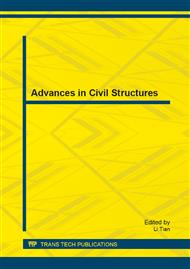p.641
p.645
p.650
p.654
p.658
p.663
p.667
p.671
p.675
An Improved Analysis Method on the Deformation Shape of Curved Plate Girders by Cold Bending
Abstract:
A typical cold bending process of curved plate girder in building construction was investigated in order to reveal the principle of deformation shape of curved I-shaped plate girder. An improved calculation method basing on geometry analysis was proposed to predict the geometric relationship between the residual deformation of curved I-shaped plate girder and the offsets of all segments in successive loading process. An example referring to the existing literatures was adopted to revise the efficiency of such an improved method. The results illustrate that the final offset distances of the key points, which were used to divide the girder into several segments with the same length, can be simply obtained by summing up the offset of each segment in once typical loading process, and the final residual deformation of curved girder was depended on the forming angle of each segment of I-shaped plate girder in once typical loading process.
Info:
Periodical:
Pages:
658-662
Citation:
Online since:
August 2013
Authors:
Keywords:
Price:
Сopyright:
© 2013 Trans Tech Publications Ltd. All Rights Reserved
Share:
Citation:


